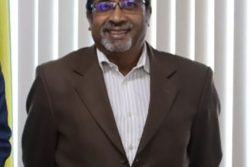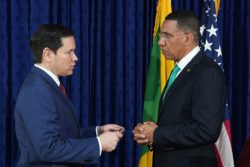Representatives of the Guyana and Norway governments will meet soon to discuss several issues related to the forest protection agreement between the two countries including revision of the interim reference level for deforestation set out in the agreement.
The 0.45% interim reference level set under the US$250 million five-year forest saving deal has been repeatedly questioned by commentators who point out that it is higher than Guyana’s historical deforestation rate and that Guyana would continue to receive payments under the agreement even if it increases deforestation. A recent report showed that the deforestation rate here was 0.02% since 1990 but this rate tripled in the first year of the agreement.
Despite the rising rate, Guyana qualified for the first payment under the Norway deal since the rate was still well below the interim reference level.
Recently, the NGO Global Witness called on both governments to renegotiate the agreement based on the reality on the ground. In response, senior adviser to Norway’s International Climate and Forest Initiative Andreas Tveteraas pointed to clauses to revise the agreement in the light of new knowledge. “The governments of Guyana and Norway recognised the many weaknesses in our knowledge on deforestation rates in Guyana at the time of establishing our partnership. Specific activities to improve this knowledge and clauses to revise the agreement in light of new knowledge were therefore included in the original agreement text,” he told the Environmental Finance website.
A clause in the agreement says that Norwegian financial support from 2011 onwards is also dependent on no national-level increase in deforestation compared to an agreed level that should be close to historical levels. This newspaper was told that a meeting is planned between representatives of Oslo and Georgetown to look at the issues.
The agreement between the two countries explicitly recognised the difficulty in setting a baseline when so little reliable information was available as to the actual rate of deforestation, and made provisions to adjust the baseline, Tveteraas said. “We firmly believe the partnership between our two countries can become a model for how a global incentive structure for reduced emissions from deforestation and forest degradation can be set up. We do not believe the model is flawless.
On the contrary, we believe we can only succeed if we learn from mistakes, and have included provisions for gradual improvements,” he added.
Norway has already paid US$30 million into the Guyana REDD+ Investment Fund (GRIF) but this first payment was an exception since third party verification of the enabling activities under the deal was not completed.
However, for this year, payment will be based on verified performance; it is a requirement that the enabling activities and the deforestation and forest degradation measurements are reported on and subjected to independent third party verification before any 2011 disbursements are made. This payment will be based on 2009-2010 results. The NGO Rainforest Alliance won the contract to verify the enabling activities.
The report from Rainforest Alliance is close to completion and will be made public shortly, Director of Norway’s International Climate and Forest Initiative, Ambassador Hans Brattskar, told Stabroek News. He said the next disbursement to the trustee of the fund will be made when the verification reports have been completed and analyzed and the funding requirements for the next period established.
Meanwhile, despite President Bharrat Jagdeo’s lambasting of the World Bank for the delay in the release of the first tranche of funds, the government is yet to submit projects for funding to the Steering Committee of the GRIF for approval.
While the World Bank is the trustee for the GRIF, it can only release funds when ordered to do so by the Steering Committee which is chaired by Guyana and comprises representatives of the governments of Guyana and Norway.
The Steering Committee approves projects for funding but the date for its next meeting has not yet been decided.
In his post-Cabinet press briefing last Friday, government spokesman Dr Roger Luncheon acknowledged that there has been “some sloth” in presenting projects. He said three main projects have been identified: the Amaila Hydroelectric project where work is ongoing in relation to the finalization of the financing aspect; the solar panels project in Amerindian communities which is being finalized for submission to the Steering Committee; and the land demarcation and titling for Amerindian communities.
“When those three projects would have been completed in their entirety for presentation to the Steering Committee, at that point in time they would deliberate and once the approval is given, then it goes over for funding and access to funding from the first annual tranche,” Luncheon said.
He did not say when the projects would be completed. “There’s some sloth, some of it is unavoidable, some of it we have been moving to correct in terms of procurement, in terms of engagements with third parties in getting the conclusion of project design and the identification of the successful tenderers who would be procuring goods or services in these three project areas,” he said.
Meanwhile, the World Bank says that all its systems are in place to disburse funds when requested. “We are ready to transfer funds as of now,” said Sergio Jellinek – External Affairs Manager for the Latin American and Caribbean Region at the World Bank.
The projects will be overseen by partner entities so far including the World Bank, the Inter-American Development Bank (IDB) and the United Nations Development Programme (UNDP). Jellinek said the transfer agreement (for funds) with the UNDP has been signed and the transfer agreements with the IDB and World Bank as partner entity have been finalized. In the case of the IDB, it needs to be approved by its Board of Directors before it can be signed and they are awaiting the conclusion of that process, he said. He said it is understood that it will take a number of weeks before the IDB’s Board can consider the agreement.
While each partner entity will have its processes to follow for a specific project, as trustee, as soon as the Steering Committee approves the project and the partner entity requests the funds, the World Bank can transfer the funds, Jellinek said. “Once we receive a cash transfer request, we can transfer the funds in a matter of days.”








